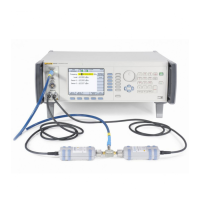Theory of Operation
Overall Functional Description 2
2-5
Head. Two level detectors are used: a LF Detector (20 kHz < frequencies >
125 MHz) and a HF Detector (125 MHz < frequencies > 4 GHz). For output levels
below approximately -60 dBm, the 60 dB attenuator is switched in, and in this
condition the level is sensed by LF and HF Detectors on the RF Output PCA prior
to attenuation.
Above 4 GHz each of the four output frequency bands of the 27 GHz Multiplier
has its own level detector. The detected output level is fed to the 27 GHz Control
PCA where it is controlled by comparing with the demand and adjusting the
appropriate voltage-variable attenuator on the 27 GHz Multiplier.
In the 96270A, when microwave output sensor/splitter leveling is selected,
automatic digital feedback is applied from the power sensor selected as the
leveling sensor. The signal level detected by the power sensor is controlled by
comparing with the required output amplitude setting and adjusting the demand
accordingly.
To offer the greatest noise immunity when connecting the Product to a UUT, the
Synthesizer PCA, 27 GHz Control and Multiplier PCAs (96270A) and the RF
Output PCA power supplies are isolated from Earth so that the instrument output
and associated RF Common are floating.
Frequency Modulation
Frequency modulated outputs are derived from a frequency modulated 100 MHz
to 250 MHz carrier signal which is generated on the Synthesizer PCA by a high
frequency DDS circuit. The modulating waveform is generated internally in the
digital domain, but a dedicated A-D converter is included to allow the instrument
to accept an external analogue modulation source.
For output frequencies greater than 125 MHz, a combination of frequency
translation and phase lock techniques are used to convert this carrier to
frequencies in the range 1 GHz to 4 GHz. This signal is then fed to the RF Output
Assembly where carrier frequencies down to 125 MHz are derived by successive
binary division. For output frequencies < 125 MHz and deviation values < 0.12 %
of the carrier frequency the output is derived by further binary division of this
signal.
For output frequencies <125 MHz and deviation values >0.12 % of the carrier
frequency the DDS signal is applied directly to the RF Output PCA, where carrier
frequencies down to 9 MHz are derived by binary division.
Amplitude Modulation
For carrier frequencies >125 MHz amplitude modulation is achieved by applying
a modulation component to the control input signals of the voltage-controlled
attenuator circuits used to control carrier amplitude. At these frequencies,
feedback from an output envelope detector is used to maintain modulation
accuracy and correct for non-linearity in the voltage controlled attenuator circuits.
To achieve the required modulation index range in this mode, the signal is also
pre-modulated by an additional voltage controlled attenuator stage in each of the
three high frequency signal paths.
For carrier frequencies <125 MHz amplitude modulation is achieved by applying
the modulating signal to an analogue multiplier which is switched into the carrier
signal forward path. In this mode the multiplier is also used to control the output
signal level.

